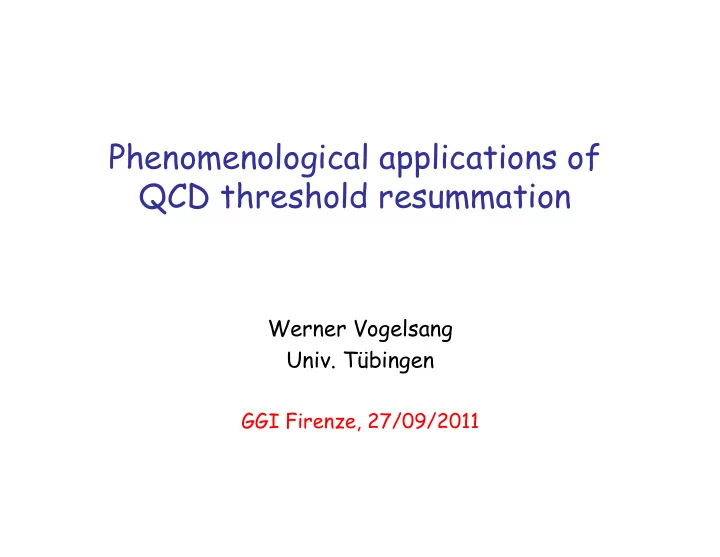

Phenomenological applications of QCD threshold resummation Werner Vogelsang Univ. Tübingen GGI Firenze, 27/09/2011
QCD threshold resummation: • Important applications at LHC: “precision QCD” (see talks of previous weeks) • Today: discuss a few phenomenological applications towards lower energies: Tevatron, RHIC, fixed target • Here, focus is to achieve quantitative description of observables
Outline: • Introduction • W boson production at RHIC • Drell-Yan process in π N scattering • Hadron pair production in pp collisions • Top quark charge asymmetry at the Tevatron Focus on phenomenology, less on technical aspects of resummation
Introduction
The archetype: Drell-Yan LO :
• NLO correction: • higher orders: . . . “threshold logarithms” • for z->1 real radiation inhibited
• logs emphasized by parton distributions : z = 1 relevant, in particular as τ→ 1
Large logs can be resummed to all orders Catani, Trentadue; Sterman; … • factorization of matrix elements • and of phase space when integral transform is taken: MS scheme • they enhance cross section !
Catani,Mangano,Nason,Trentadue to NLL (much more is known):
Inverse transform: “Minimal prescription” Catani,Mangano,Nason,Trentadue “Matching” to NLO:
W boson production at RHIC A. Mukherjee, WV
Polarized pp collider RHIC
W boson production: u unpol. goal: probe proton’s helicity distributions use Parity Violation:
• so far, obtained from SIDIS: DSSV: de Florian, Sassot, Stratmann, WV • insight into QCD via models (large-N c , chiral quark, meson cloud,…)
Recent NLO calculation: de Florian, WV
STAR (also Phenix)
B. Surrow (STAR) de Florian, WV
W moderately large
Introduce
No dependence on near threshold:
W + Mukherjee, WV
Drell-Yan process in π N scattering M. Aicher, A.Schäfer, WV
Drell-Yan is key focus in nucleon structure physics: • in pp, pN: probe of anti-quark distributions • in π N: probe of pion structure • probe of spin phenomena: TMDs, Sivers effect Currently: E906 ongoing near-term plans RHIC, COMPASS future possibilities J-PARC, FAIR
• Drell-Yan process has been main source of information on pion structure: E615, NA10 µ + µ - • Kinematics such that data mostly probe valence region: ~200 GeV pion beam on fixed target
• LO extraction of u v from E615 data: Holt,Roberts QCD counting rules Farrar,Jackson; Berger, Brodsky; Yuan Blankenbecler,Gunion, Nason Dyson-Schwinger Hecht et al.
(Compass kinematics) Aicher,Schäfer, WV (earlier studies: Shimizu,Sterman,WV,Yokoya)
Hadron pair production L. Almeida, G.Sterman, WV
pair mass 2 • in some sense, a generalization of Drell-Yan to “completely hadronic” situation • data: fixed target (NA24,E711,E706) ISR (CCOR) • typically ok with NLO only if small scales are chosen (~ M/3) Owens, Binoth et al.
Differences w.r.t. Drell-Yan: • color structure of hard scattering • fragmentation -> only part of parton pair mass is converted to observed pair mass
Define where
Take moments : -> works only at LO
Instead, write
LO: NLO: true to all orders
π π
Kidonakis,Oderda,Sterman matrix problem Bonciani,Catani,Mangano,Nason Banfi,Salam,Zanderighi Dokshitzer,Marchesini this part depends on scattering angle ! algebra done numerically
GeV sets new scale
Top quark charge asymmetry L. Almeida, G.Sterman, WV
Charge asymmetry: _ _ p p p p vs Differential in rapidity : Integrated:
in : charge asymmetry leads to forward-backward asym.: also:
Less diluted for
Tevatron : D0: not corrected for acceptance or reconstruction SM expectation (MC@NLO): ~ 1% CDF: fully corrected SM expectation: ~ 6% SM expectation: ~ 4%
- Tevatron: ~85% of cross section is from qq LO symmetric in : no A ch electroweak: tiny (no interference with QCD )
however, at : Brown,Sahdev,Mikaelian ‘79 Halzen,Hoyer,Kim ’87 Kühn,Rodrigo ‘98 QED: Berends,Gaemers,Gastmans ’73 Putzolu ‘61 in QCD, effect involves color factor
diagrams are subset of full NLO, and therefore also included there Beenakker et al., Ellis,Dawson,Nason, MCFM (Campbell,Ellis,et al.) MC@NLO (Frixione et al.) however, for asymmetric part, they are LO as a result, loops are UV-finite diagrams also collinear-finite: single IR divergence that cancels between real & virtual
Stability of this prediction ? Why (might need to) worry: only LO NLO gives ~30% correction to cross section, significant scale uncertainty NLO for charge-asymmetric part not available (would be part of NNLO for full cross sec.) -> i nvestigate higher orders of perturbation theory
similar to dihadron resummation: like Drell-Yan depends on scattering angle roughly: Almeida,Sterman,WV leading-log part cancels in A FB
Almeida,Sterman,WV
general trend is like CDF data, but less pronounced stability of results confirmed to NNLL Ahrens,Ferroglia,Neubert, Pecjak,Yang
Recommend
More recommend